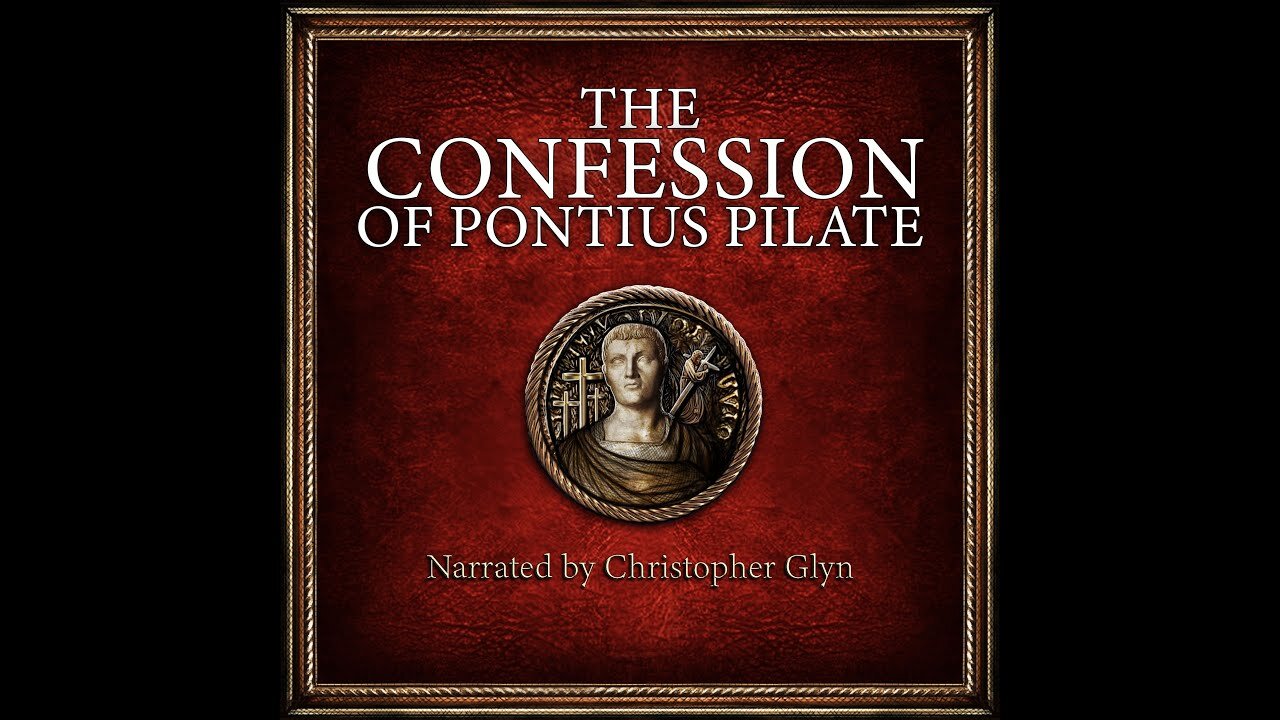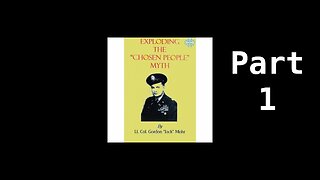Premium Only Content

The CONFESSION of Pontius Pilate 📜 Full Audiobook With Text - Narrated by Christopher Glyn
The CONFESSION of Pontius Pilate 📜 Full Audiobook With Text
Narrated by Christopher Glyn
Length 2:16:48
Date: Oct 20, 2024
Video Source Christopher Glyn's YouTube Channel: https://www.youtube.com/@christopherglyn
First written, as alleged, in Latin, by Fabricius Albinus, a playmate of Pilate; translated into Arabic by Jerasimus Jared, late Bishop of Zahleh, in Lebanon and rendered from the Arabic into English by B. Shehani in 1893
The Confession of Pontius Pilate" is a fascinating dramatic dialogue between Pontius Pilate and his close friend Fabricius in which he recounts, from his perspective, the events surrounding the trial, crucifixion, and resurrection of Jesus Christ.
Whether the author was Fabricius himself, or it was written by an unknown author at a later date, the story sticks closely to the biblical narrative while providing additional insights into the internal conflicts of Pontius Pilate over his role in the crucifixion of Jesus Christ that led to his eventual suicide.
NOTES:
Note 1: Vienne was a very ancient city of the Province of Narbonne, famous in ecclesiastical history as the early seat of a bishopric in Gaul.
Pilate’s tomb, a curious monument, 52 ft. high, is still shown at Vienne according to Hastings’ Dictionary of the Bible. Vol. III p. 878.
According to Eusebius, Pilate committed suicide in Vienne about A. D. 38.
Note 2: Lucius Vitellius is frequently commended by Josephus for his kindness to the Jews. When Emperor Claudius was absent upon his expedition into Britain, the care of the Empire was committed to him.
Note 3: A Samaritan told his countrymen that he could show them the Sacred vessels at Mount Gerizzim supposed to have been hid there by Moses. The Samaritans came armed and gathered in a village called Tirathaba, Pilate prevented them from going up the Mount and fell upon them with his army, slaying many.
After the tumult was appeased, the Samaritans appealed for redress to Vitellius, Governor of Syria, pleading that no political sedition had been intended. Vitellius then caused Pilate to repair to Rome to answer the accusations of the Jews, and appointed Marcellus to take charge of the affairs of Judea. (Josephus XVIIT-IV.)
Note 4: En-Gedi is a village situated on the western side of the Dead Sea, and in a south-easterly direction from Jerusalem. It is celebrated for the fertility of its vineyards. (Song of Solomon 1:14).
Note 5: Socrates was born about the year 470 B.C.; died by poison at Athens when he was about seventy years old.
Note 6: Pilate’s wife is represented as having been a proselyte of the gate and a secret disciple of Jesus. She is commemorated as a saint in the Greek Church on Oct. 27. —Encyc. Brit.
Note 7: Simon, from Cyrene, in Africa, now called Tunis.
Note 8: Eloi, Eloi, lama sabachthani?
Note 9: That Pilate made a report to Tiberius concerning Jesus is affirmed by Justin and Tertullian.—Hastings Dictionary of the Bible.: Lardner says, Pilate must have sent a report to Rome concerning Christ. A translation of Pilate’s Report, published in 1913, contains some of the facts mentioned in this Confession, as published in 1893.
Note 10: According to the Greek Mythology, Charon was a god of the infernal regions who conducted the souls of the dead in his boat over the rivers Styx and Acheron, bringing them to Hades—the world of the Spirits.
~
Pontius Pilate's account of the events leading up to Jesus's arrest, the accusations brought against him by the High Priest of the Jews; Caiaphas, his trail, conviction, crucifixion and resurrection are recorded in 3 Books, Acta Pilate, Gesta Pilate and The Archko Volume. Justin Martyr, Tertullian and Eusebius and Josephus. attest to Pontius Pilates writings.
URL OF LETTER: https://archive.org/details/pontius-pilates-letter-to-tiberius-caesar-archko-volume
GESTA PILATE BOOK: https://archive.org/details/gesta-pilate-the-reports-letters-and-acts-of-pontius-pilate/page/n1/mode/2up
GESTA PILATE PDF: https://ia600704.us.archive.org/35/items/gesta-pilate-the-reports-letters-and-acts-of-pontius-pilate/gesta-pilate-the-reports-letters-and-acts-of-pontius-pilate.pdf
ACTA PILATE BOOK: https://archive.org/details/acta-pilate-testimony-of-pontius-pilate-to-emperor-tiberius-caesar-crucifixion-of-jesus
ACTA PILATE PDF: https://dn721702.ca.archive.org/0/items/acta-pilate-testimony-of-pontius-pilate-to-emperor-tiberius-caesar-crucifixion-of-jesus/acta-pilate-testimony-of-pontius-pilate-to-emperor-tiberius-caesar-crucifixion-of-jesus.pdf
THE ARCHKO VOLUME BOOK: https://archive.org/details/archko-volume-the-archeological-writings-of-the-sanhedrin-and-talmud-of-the-jews
THE ARCHKO VOLUME PDF: https://dn721602.ca.archive.org/0/items/archko-volume-the-archeological-writings-of-the-sanhedrin-and-talmud-of-the-jews/archko-volume.pdf
ROMAN EMPIRE MAP: https://archive.org/details/roman-map-israel-judah-large
Barabbas means “son of the father”. He, the son of the father, went free while Jesus, the Son of the Father, was condemned. Barabbas was guilty while Jesus, innocence itself, was punished.
Adam, the first son of God, along with Eve both secumbed to the temptations of the serpent; and in so doing they ushered in sin and death, which is separation from God.
The Old Testament contained instructions for the sacrificing of unblemished lambs to atone for our sins. Jesus's sacrifice ended the need for that, as His sacrifice covers our sins from that moment forward. The entire time during this event, and since he was baptised by John the Baptist, he was aware of the suffering he would endure, and did so willingly because of his love for us. He was not unaware of all of the details, well before they unfolded.
If Satan knew that Jesus's sacrifice of his life's blood, provided the atonement for sin, that we require to regain right standing with God. He would never have orchestrated the events to bring about Jesus's crucifixion. Jesus knew of Satans plan, and did not attempt to evade them or change them, knowing that his sacrifice would redeem mankind, all the while Satan thought he was finally disposing of Jesus. The ultimate irony, was that the Jewish Authorities, Pharisees, and the crowds deceived by the High Priest Caiaphas and Annas, and paid to raise a commotion, demanded that Barrabas, a murderer be released, whose name means "Son of the Father".
Redeemed means to buy back, to buy us back from our sinful nature, we cannot do this in and of ourselves, Jesus knew this. Those who accept His free gift of sacrifice are essentially "washed in his blood" and clothed in white robes, as his blood washes away our sins, enabling us to stand "Holy" and sinless in the presence of God.
Just as Jesus offered no complaint when Barabbas was freed instead of him, he offers no complaint in freeing us from our sins. He suffered in silence so we, the sons and daughters of God, could be free.
On Judgement day, a payment for sin will be required, those who have not accepted Jesus's sacrifice of his life as payment for their sin, will have to pay with their own lives.
Content, Videos, Audiobooks, and more may be viewed on my Rumble Channel: https://rumble.com/c/LiesThatBind
Content, Videos, Audiobooks, and more may be viewed and downloaded from: https://archive.org/details/@liesthatbind
~
GESTA PILATI - THE REPORTS, LETTERS & ACTS OF PONTIUS PILATE
BEING THE OFFICIAL RECORDS OF PILATE AS MADE TO TIBERIUS CAESAR EMPEROR OF ROME, CONCERNING THE APPREHENSION, TRIAL AND CRUCIFIXION OF JESUS OF NAZARETH.
TRANLATED CHIEFLY FROM TISCHENDORF'S MANUSCRIPT ACTS DECLARED TO HIM TO BE TRUE COPIES OF THE ORIGINAL AS USED BY JUSTIN MARTYR, AND AS REFERRED TO BY TERTULLIAN AND EUSEBIUS.
BY W.O. CLOUGH, B. A.
PUBLISHED BY - ROBERT DOUGLASS: INDIANAPOLIS, IND. 1883.
INTRODUCTION:
The volume here presented is a collection of the papers of Pontius Pilate, officially made to the Emperor of Rome, Tiberius Cesar, concerning the apprehension, trial and crucifixion, of Jesus of Nazareth.
The documents are translated chiefly from manuscripts discovered by the late eminent Dr. Constantine Tischendorf. Each document is accompanied by such notes as make its history clear to the ordinary reader, and at the same time there is placed before the critical enquirer the opinions of the learned of ancient and modern times in regard to the value attached to these very remarkable papers.
No similar collection of these documents has been heretofore made, and while doubts may be entertained as to the genuineness of some of them, yet, in the main, it must be confessed, that very few of the writings that have come down to us from early antiquity can claim such a confirmation of their text as is possessed by these deeply interesting documents. They are therefore presented to the reader not only as an historic account of, but a most valuable direct testimony to the truth of Christianity.
So little testimony from outside sources, from the civil history of the time (and all of that little so indirect in its character), has been preserved to us—that it renders such as is here presented in the body of these papers of very great interest and importance. Especially do we need historical testimony of this sort in the great controversy that to-day may be called the greatest question of the age—whence is Jesus? And in the solution of this, no respectable testimony on one side or the other of this problem should be discarded. It is no longer a question as to whether testimony of an historical character is needed by the advocates of Christianity.
The time is already present when it must be shown that Jesus Christ is an historic person. The life of Jesus is the center of the religious controversies that agitate our age, and the great question that demands solution is whence is the man Jesus? Is he an historical person orishe not? The settlement of this one question, says the eminent Tischendorf, is decisive of the question whether the Church shall or shall not live—the most momentous of all questions which the Church has to encounter. To rob him of his historic greatness, and yet to think to retain the Christian faith and the Christian Church, is a futile attempt, a vain mockery, says the same eminent critic and writer.
It becomes, therefore, the duty of all Christians, and especially of our clergymen, theological students and professors, to furnish themselves from the armory of history with the weapons that alone can be employed in the overthrow of that unbelief upheld by a well organized movement, which to-day threatens to convert theological science into sophistry, and so give powerful support to the antichristian spirit of our time. To do this must be done by rigid inquiry in the field of historie research, rather than by any other direction or through any other means. Jesus did not scruple to stand before kings or governors, nor scribes or doctors. His apostles did not fear to plead before the elders, the priests, the kings, the governors nor emperors. Their advocacy was fearless because invulnerable in its claims, whether in an humble Jewish synagogue or in the halls of philosophy, at Jerusalem or in Rome. They spoke well attested facts; they bore incontestable testimony to those facts, and this alone made them invincible and invulnerable.
Can we do the same to-day? Are we invincible and invulnerable? — historically, I mean. Can we stand before such a tribunal as the Roman Senate and the Emperor, as stood Justin Martyr? Can we allege that the facts occurring in the presence of his own appointed governor, Pontius Pilate, and reported by him, were facts in his own possession, written in the official documents made under his governor’s own knowledge, and claim that they were fulfilled in the person of Jesus Christ? If we can we ought to do it, and if we can not we ought to know the reason why, and to acknowledge our shame that it has been stated by Christian writers that it ever was done. Who are these Christian writers? No less men than our Justin Martyr, our Tertullian, and our father of history in the Church, Eusebius. When did they do these things or report that they were done? In the year A. D. 138, Justin; about the year A. D. 200, Tertullian, and about A. D. 815, Eusebius.
These are the men. They are prominent and widely, widely known. We have their writings. They were all scholars, learned men, cultured men, eminent for their learning. They knew of the reports which Pilate made from Judea to his emperor, Tiberius Cæsar, at Rome, concerning Jesus. They knew what they contained as to the wonderful occurrences at, before and after the crucifixion. They were not only acquainted with all this, but were bold (two of these at least, Justin and Tertullian) to tell the highest man in Rome that he did or could know these wonderful things about Jesus by simple reference to the papers drawn up under Pontius Pilate. This is simply the history in brief of the Pilate papers as known to these three eminent men, Justin, Tertullian and Eusebius, Every Christian ought to know such an important scrap of history, and, ¿f possible, obtain the papers of Pilate, and to know that it is his duty to circulate such respectable testimony as they contain, as did the good and eminent men above named, bear it before the great Emperor and his Roman Senate and to the world around them.
The reader of these lines need not be in doubt as to the papers, or the testimony they bear, for the reason that he may fear that the papers have been lost or destroyed, as they were attempted to be in A. D. 811, under Maximin’s reign. We adduce authority here which will allay any fear and cast out all doubt as to whether we have the Pilate papers. We adduce the remarks of Dr. Constantine Tischendorf as taken from Mr. William L. Gage’s translation, under the sanction of Dr. Tischendorf, and as found in his “Origin of the Four Gospels.” (See Origin of the Four Gospels, by Constantine Tischendorf, p. 141, et seq. American Tract Society, 28 Cornhill, Boston, 1868.)
We adduce him as the most competent and intelligent critic in the matter under question. In commenting upon these papers of Pilate’s, Dr. Tischendorf says:
“Justin, in like manner as before, is the most ancient voucher for this work, which is said to have been written under Pilate’s jurisdiction, and by reason of its specification of wonderful occurrences before, during and after the crucifixion, to have borne strong evidence to the divinity of Christ. Justin saw as little reason as Tertullian and others for believing that it was a work of pious deception from a Christian hand.” [As has been alleged often by opponents.] “On the contrary, Justin appeals to it twice in his first apology in order to confirm the accounts of the occurrences which took place at the crucifixion in accordance with prophecy, and of the miraculous healings effected by Christ, also the subject of prophetic announcement. He cites specifically (chap. 85) from Isaiah Lxv. 2, and Lv. 2: ‘I have spread out my hands all the day unto a rebellious people which walketh in a way that was not good. They ask of me the ordinances of justice; they take delight in approaching to God.’ Further, from the 22d Psalm: ‘They pierced my hands and my feet; they parted my garments upon them and cast lots upon my vesture.’ With reference to this he remarks that Christ fulfilled this; that he did stretch forth his hands when the Jews crucified him—the men who contended against him and denied that he was Christ. ‘Then,’ he says further, ‘as the prophet foretold, they dragged him to the judgment seat, set him upon it and said, ‘judge us.’ The expression, however, ‘they pierced,’ etc., refers to the nails with which they fastened his feet and hands to the cross. And after they had crucified him they threw lots for his clothing, and they who had taken part in the act of crucifixion divided it among themselves.’ To this he adds: ‘And you can learn from the Acts, composed during the governorship of Pontius Pilate, that these things really happened.’
“Still more explicit is the testimony of Tertullian, It may be found in Apologeticus (chap. 2), where he says that out of envy Jesus was surrendered to Pilate by the Jewish ceremonial lawyers, and by him, after he had yielded to the eries of the people, given over for crucifixion; that while hanging on the cross he gave up the ghost with a loud ery, and sò anticipated the executioner’s duty; that at that same hour the day was interrupted by a sudden darkness; that a guard of soldiers was set at the grave for the purpose of preventing his disciples stealing his body, since he had predicted his resurrection, but that on the third day the ground was suddenly shaken and the stone rolled away from before the sepulcher; that in the grave nothing was found but the articles used in his burial; that the report was spread abroad by those who stood outside that the disciples had taken the body away; that Jesus spent forty days with them in Galilee, teaching them what their mission should be, and that after giving them their instructions as to what they should preach, he was raised in a cloud to heaven. Tertullian closes this account with the words, ‘All this was reported to the Emperor at that time, Tiberius, by Pilate, his conscience having compelled even him to become a Christian.
~
THE ACTA PILATI
IMPORTANT TESTIMONY OF PONTIUS PILATE RECENTLY DISCOVERED, BEING HIS OFFICIAL REPORT TO THE EMPEROR TIBERIUS, CONCERNING THE CRUCIFIXION OF CHRIST.
EDITED BY REV. GEO. SLUTER, A. A.,
LATE SECRETARY MISSIONS, PRESBYTERIAN SYNOD OF MISSOURI.
PUBLISHED BY M. B. ROBINS, SHELBYVILLE, IND. 1879.
PREFACE
My object in publishing this book is to show that the historic evidence for the history contained in the Gospels is ample and explicit. If unbelievers demand heathen testimony concerning the origin of Christianity, here it isin abundance, and of the clearest kind. By glancing through the Table of Contents it will be seen, that the testimony of the Roman procurator is here surrounded by many great writers of remote antiquity. I could have given still more, but these will suffice to show how full is the Historic Evidence for Christianity.
It may perhaps be necessary to guard the reader against supposing this to be the spurious or forged Acta, to which allusion is made by many writers.
The best and most complete edition of these is that of Fabricius (Codex Apocryphus, Edition 1703). A full and accurate literal translation may be found in the 19th volume ofthe Ante-Nicene Library, published by T. & T. Crarx. Edinburgh, 1870. They are certainly spurious, and the inventions of a later day. They are full of absurdities and almost utterly unworthy of respect. But the Vatican copy, which I here present, is an entirely different paper. I have carefully examined the Acta Paradosis, Mors, and Epistolae Pilati, both in the*Latin and Greek forms, and I assure the reader there is not a line or trace of similarity between them and this document. It will speak for itself. I think the internal evidence is such as cannot fail to produce conviction upon careful examination. The very fact that it does not give anything new or singular is in favor of its genuinene ss. In this it differs entirely from the contents of the Apocryphal writings. It is interesting also to notice the statement of Pilate, that he trembled, when Jesus for the first time entered his presence—why did he tremble? There was good reason forit. He was in the presence of the Son of God. Among the internal evidences of its genuineness I cannot refrain from calling special attention to what Pilate says of the Resurrection. He does not say that Jesus arose from the dead, but that his tomb was found empty.
The style proves it to be the true Acta. It is not in the corrupt Latin of the Apocryphal Acta Paradosis, Mors, and Epistol, but in the pure and glowing rhetoric of the Classic period of Roman Literature.
The discovery of this long lost testimony of Pilate, amid the vast mass of unedited parchments in the Vatican, is certainly an event of extraordinary importance in the history of the Christian Evidences.
I would suggest to the reader, to study the text of the Acta in the light and with the aid of the Historical and Critical Notes. They contain matter necessary to be understood, and will richly repay careful perusal. Indeed, they are essential to the completeness of the impression to be produced by the book.
Its preparation has been a source of great pleasure and satisfaction to me, and that it may prove of advantage to others, is my sincere and earnest desire.
G.S.
SHELBYVILLE, INDIANA, September, 1879.
~
THE ARCHKO VOLUME; OR THE ARCHAEOLOGICAL WRITINGS OF THE SANHEDRIM AND TALMUDS OF THE JEWS. (INTRA SECUS.) THESE ARE THE OFFICIAL DOCUMENTS MADE IN THESE COURTS IN THE DAYS OF JESUS THE CHRIST.
How these records were discovered.--A short sketch of the Talmuds.--Constantine's letter in regard to having fifty copies of the Scriptures written and bound.--Jonathan's interview with the Bethlehem shepherds.--Letter of Melker, priest of the synagogue at Bethlehem.--Gamaliel's interview with Joseph and Mary and others concerning Jesus.--Report of Caiaphas to the Sanhedrim concerning the execution of Jesus.--Report of Caiaphas to the Sanhedrim concerning the resurrection of Jesus.--Valleus's notes.--"Acta Pilati."--Herod Antipater's defence before the Roman senate in regard to his conduct at Bethlehem.--Herod Antipas's defence before the Roman senate in regard to the execution of John the Baptist.--The Hillel letters regarding God's providence to the Jews, by Hillel the Third
BY: Mahan, W. D. (William Dennes), 1824-1906; McIntosh, M; Tywman, T. H
PUBLICATION DATE: 1913
PUBLISHER ANTIQUARIAN BOOK CO. PHILADELPHIA
~
-
 27:21
27:21
LiesThatBind
2 months agoExploding the Chosen People Myth Colonel Jack Mohr Part 1
257 -
 2:08:25
2:08:25
Side Scrollers Podcast
19 hours agoEXCLUSIVE: Marty O’Donnell BREAKS SILENCE On Bungie Drama + Kotaku Hypocrisy + MORE | Side Scrollers
9.41K2 -
 2:31:49
2:31:49
MattMorseTV
19 hours ago $0.49 earned🔴Trump's Oval Office BOMBSHELL.🔴
24.2K45 -
 25:14
25:14
GritsGG
15 hours agoRank 1 Player Spectates Casual Solos!
9.41K -
 LIVE
LIVE
Lofi Girl
2 years agoSynthwave Radio 🌌 - beats to chill/game to
748 watching -
 4:33:40
4:33:40
FreshandFit
9 hours agoAfter Hours w/ Girls
235K118 -
 2:33:36
2:33:36
Badlands Media
10 hours agoOnlyLands Ep. 21: From Trump’s VP Pick to Green Energy Grift
68.3K8 -
 1:07:26
1:07:26
Inverted World Live
13 hours agoThe War Against Robots w/ Joe Allen
98.4K5 -
 6:08:31
6:08:31
SpartakusLIVE
13 hours agoWARZONE NUKE IS BACK?! || Solo Challenge CHAMPION to start, duos w/ the Dawg later
102K1 -
 1:00:18
1:00:18
Man in America
14 hours agoBig Pharma’s Empire of Lies Is COLLAPSING as People Turn to Natural Medicine
65.1K25